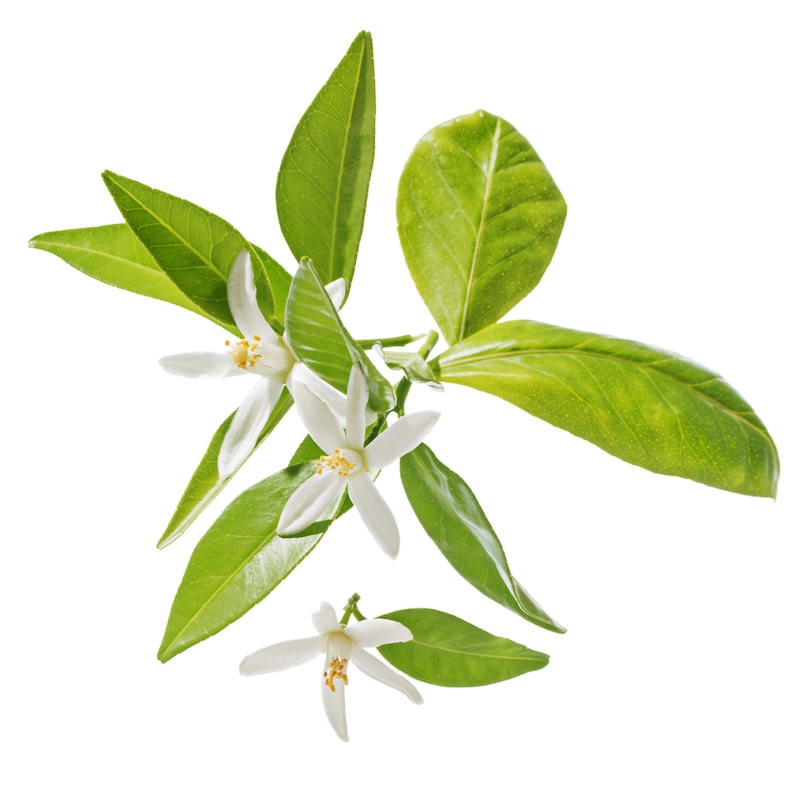Petitgrain and neroli are both oils yielded by the orange tree. The leaves contain tiny sacs of oil that, steam-distilled, release petitgrain oil, while petals are steam-distilled to give neroli oil. Petitgrain's haunting fragrance is reminiscent of neroli, but is lighter and more refreshing.
The sweet and the creamy
The sweet aroma of petitgrain makes it a fragrant cosmetic oil. A tonic for all complexions, its cooling actions clear blemishes and promote skin growth. It restores the emotions, stimulates the immune system and refreshes the body.
Neroli, with its rich, creamy scent, is worth its expense. It's used in perfume and the classic eau-de-cologne, but it's not just a sensual affair - neroli is a natural relaxant, making it one of the most effective oils for anxiety.
Ingredients of these Oils
Neroli and petitgrain oils share some, but not all, active ingredients.
Esters
Both oils contain esters, especially linalyl acetate, which contributes to the fruity odour. Esters are also cooling and antiseptic.
Monophenol alcohols
These make up 40% of neroli and include nerol, linalool and geraniol. They contribute to neroli's warming effects. Linalool, with geraniol, terpineol and nerol, are also present in petitgrain. They act as a balancing tonic and are responsible for its immuno-stimulant properties.
Monoterpenes
Monoterpenes, such as limonene and pinene, are abundant in neroli. They are antiseptic and antiviral. The compounds evaporate fast and are prone to oxidation.
Uses of neroli and petitgrain
Neroli and petitgrain can both be used for such things as calming blends and skincare, but petitgrain is the more effective invigorating oil, while neroli is an exquisite love perfume.
Sensual Perfume
Use the haunting fragrance of neroli to create calming and sensual moods.
Bring romance into a relationship by replacing emails with scented love letters. Add a single drop of neroli to a letter before sealing it in an envelope.
Scent your bathroom with a seductive room sprat by adding 5 drops each of neroli and ylang ylang to half a litre in a spray bottle

Create your own refreshing eau-de-cologne with 2 drops each of lime and neroli, 10 drops each of bergamot and orange, 5 drops of lemon and 50ml of 100% proof alcohol. Add 30ml of still spring water and leave to stand for a month before bottling.
Spend a romantic evening in front of an aromatic log fire. Add 3 drops each of neroli and jasmine to each log.
Refresh your Mind and Body
Petitgrain is calming but also uplifting for both the body and mind.
Invigorating Massage
To refresh you and sharpen your senses
- 4 drops petitgrain
- 3 drops lemon
- 2 drops basil
- 25ml grapeseed oil
Bath to Boost Body and Mind
For a zesty bath, add 3 drops of petitgrain and bergamot and 1 drop of grapefruit.
Using Nature's Tranquilliser
Both neroli and petitgrain have exceptional tranquillising properties.
Shock Treatment

As a first aid treatment for shock, emotional trauma or panic attacks, add 2 drops of neroli oil to a handkerchief and inhale deeply until feeling calm.
For Meditation
Promote mental clarity and peaceful concentration during meditation or Yoga by adding to a room diffuser:
- 5 drops petitgrain
- 4 drops cinnamon
- 2 drops orange
Soft Complexion
Petitgrain softens the skin, while neroli's regenerative action helps its natural texture.
Refresh your skin
Add a couple of drops of petitgrain oil to a basin of water and splash your face.
Aromatic yoghurt face mask
Improve your complexion by applying:
- 3 drops neroli
- 3 drops jasmine
- 2 tbsp plain live yoghurt
Folklore
Like their scents, the folklore history of there fragrances is rich and exotic.
Neroli oil is named after the Italian Countess Anne Marie, of the kingdom of Neroli, who perfumed her gloves with the oil of orange flowers.
Orange flowers mean 'innocence' and symbolise the purity of the bride in Mediterranean wedding bouquets.
Petitgrain oil was at one time extracted from the tiny, green, unripe oranges - hence the name petitgrains, or 'little grains'.